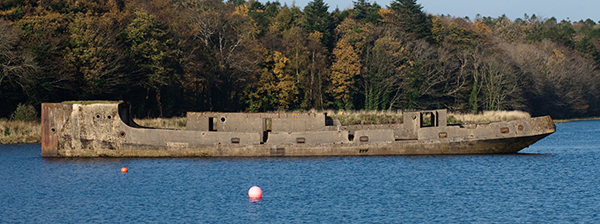SS Creteboom
Published in Gems of Architecture, Issue 5 (September/October 2020), Volume 28Ballina, Co. Mayo
By Damian Murphy
The River Moy at Ballina is the permanent home of a vessel that has beguiled the observer ever since it first appeared there in the 1930s. Built of concrete, the SS Creteboom owes its origins to a steel shortage during the First World War. By 1917, accelerated war production had put a strain on steel supplies. A new fleet of barges and tugboats was required to carry iron ore from northern Spain. To build that fleet with steel was counterproductive, however, and so, continuing an experiment that saw the first ferro-cement vessel exhibited by Joseph-Louis Lambot (1814–87) at the Paris Exposition Universelle in 1855, the ‘concrete ship’ was born.
It was hoped that the new fleet would be cheap and quick to complete, and that the concrete hulls would be impenetrable to mines and torpedoes. With an order for 154 vessels, including 24 tugboats, from the Ministry of Shipping, construction began in a number of adapted or purpose-built shipyards. Guy Anson Maunsell (1884–1961), a civil engineer and officer in the Royal Engineers, became chief engineer at John ver Mehr’s shipyard at Shoreham-by-sea, West Sussex, in 1918 and designed the shipyard and the tugboats it produced.
Building the tugboats involved a skeleton of precast concrete with steel bar reinforcements—the demand for steel bars was less than that for steel plates and allowed for their use in reinforced concrete. An exterior formwork of shaped timber coupled with an interior formwork created the void necessary for poured concrete from the Shoreham cement works. Once set, and the formwork removed, the hull was sealed with a layer of cement, a layer of bitumen (pitch) and a painted finish. Only the rudderpost and skylights required steel, while the bridge and deck were built of timber.
Unfortunately, the brief for cheap and quick production could not be met. Not only did each tugboat cost on average £27,000, compared to £17,000 for the steel version, but only one vessel had been completed when the war ended in November 1918. The original order was cancelled and only those barges and tugboats in an advanced state of construction were eventually completed—a total of 66 vessels in all, including twelve tugboats.
In 1922 ten tugboats and 39 barges were purchased by Stelp and Leighton, London, for the new Crete Shipping Company to transport coal to the Continent. The venture was short-lived and ceased in 1924. The SS Creteboom remained moored on the River Wear until it was sold in 1935 to the South Stockton Shipbreaking Company of Thornaby-on-Tees. It was stripped of its recyclable materials and only the reinforced concrete hull survived.
The SS Creteboom made its way to County Mayo in 1937, when it was purchased by the Ballina Harbour Commissioners for the purpose of sinking it and other obsolete vessels to form a groyne to keep the navigation channel clear at the mouth of the River Moy. Colliding with another vessel as it was being towed into position and damaged below the water-line, the SS Creteboom drifted mid-channel and sank. Successfully refloated by the OPW in 1974, the hull was towed to its present position by Belleek Woods to prevent the build-up of sand and damage to the salmon fisheries.

Above: The SS Creteboom at its present location on the River Moy at Belleek Woods. (James Fraher)
Damian Murphy is Architectural Heritage Officer, National Inventory of Architectural Heritage. Series based on the National Inventory of Architectural Heritage’s ‘building of the month’, www.buildingsofireland.ie.
















